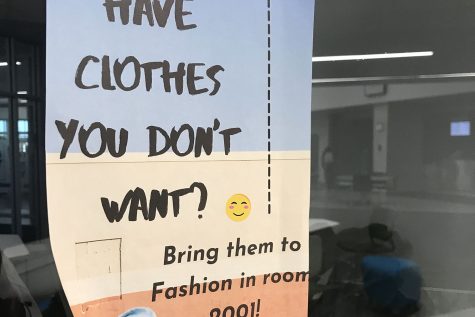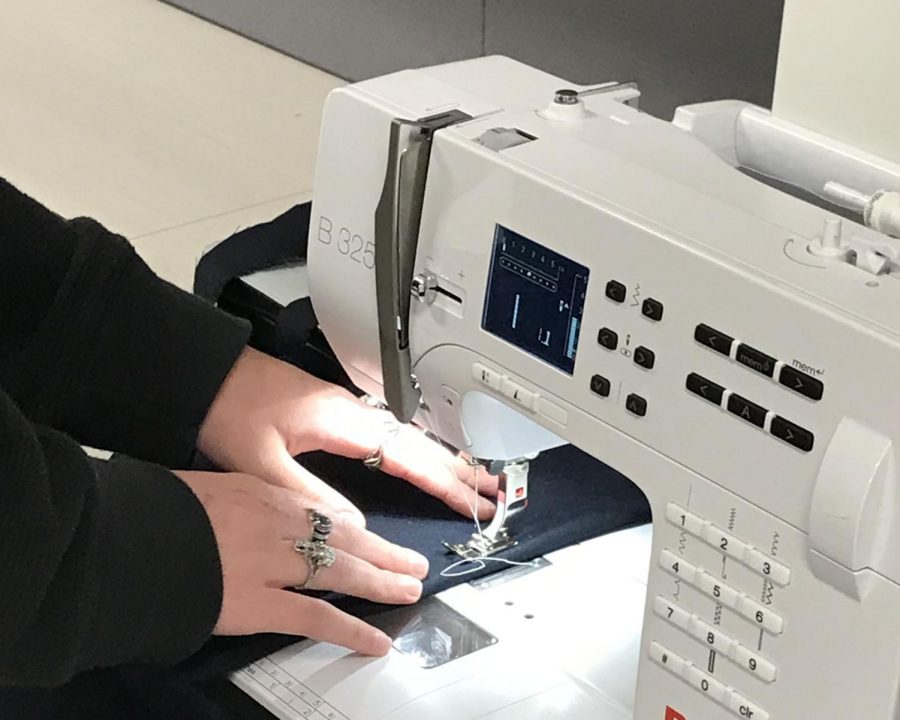Opinion: School fashion department weighs in to encourage sustainable fashion practices
Junior Emma Palmese sews for a project in the school’s fashion room. “I honestly think more people should get into sewing. It’s less wasteful. Some people throw away shirts if they need a button sewn.” The fashion department took in clothing donations from students to use for their spring fashion show, opting for a more sustainable production.
Among the list of things teens care about, fashion is very close to the top. This is evident in the number of successful clothing brands that cater to young people. As emerging brands and online shopping make these clothes increasingly accessible, fashion trends keep shifting and teenagers embrace the new looks.
By 2014 the number of garments produced in a year, chiefly by Western fast fashion companies, was 100 billion, double the production of just a decade earlier. As the norm for fashion lines progressed from new looks every season to additions almost daily, fashion production had to adapt, even though that meant becoming more unfair, exploitative, and wasteful.
“Fast fashion’s unethical [nature] is public knowledge; we all know it,” Rock Hill High School junior Emma Palmese said. Palmese is a part of the school’s fashion program and wants fashion to be fun while also being environmentally friendly. “No one wants to think about it. It’s hard to know that a 12-year-old kid somewhere is working in a factory making clothes for greedy teens and still [eagerly] participate in the industry,” Palmese said.
The wants of first-world consumers have commonly encouraged the exploitation of poorer countries. It used to be manifest in colonialism, but Western corporations continue to abuse their power, just less overtly. With its outsourcing of labor and use of developing nations as dumping grounds for discarded clothes, fast fashion attests to this problem.
“The idea is that if we produce them cheap enough, you can purchase them cheap enough and afford to keep updating styles,” RHHS debate coach Josh Wurzman said. “You could say these countries [with outsourced textile labor] are getting jobs, but wouldn’t they benefit more if we found industries that didn’t do as much damage? If we paid them a living wage? What we want is the lowest cost: it may not be what’s best, but it’s what suits our needs at the time.”
Wurzman is careful to buy well-made clothes so that he doesn’t have to discard them once they wear out. He also doesn’t feel the need to conform to trends, so he doesn’t grow tired of his old clothes. Still, he doesn’t think of himself as a good example of ethical fashion practices.
“I have 350 ties and bow ties, 15 suits and like 70 button-up shirts,” Wurzman said. “I definitely own way more clothes than I need. But I love variety. I never repeat ties in a school year.”
He wants students to know that they can be comfortable and experimental with their fashion while still being conscious of their clothing choices. One way to do this is by donating or finding a way to reuse old clothes.
“I’ve gotten into thrifting since last year. I would buy things that didn’t fit right and alter it,” Palmese said. “I sew, and I turn these clothes into something I can actually use.”
Thrifting has become less unusual, mostly to people for whom thrifting is not a monetary necessity but a choice. With ‘thrift flips’ getting popular on TikTok and tutorials being created on how to upcycle clothes, social media has encouraged teens to rethink their wardrobes in a more sustainable way. However, the trend of ‘Shein hauls’ on TikTok, promoting a brand that is notorious for its ultrafast fashion and cheaply made clothes, shows that it goes both ways.
“This social media culture has made thrifting almost trendy where it used to be that you’re dirty because you need to buy used clothes,” Palmese said. “But these sites are also where brands like Shein put their advertisements on.”
RHHS junior Nadia Tayyem has a different opinion on thrifting. The popularity of buying used clothes no matter one’s income bracket, Tayyem thinks, will discourage buying from actual sustainable fashion brands, creating less waste and pollution in the longer run. In addition, the low quality of fast fashion makes it hard to recycle the fabric later on. Ethical fashion brands make sure clothes are recyclable and use fair labor practices, but their prices are higher.
“Some people see thrift stores as more of a convenience rather than a necessity, and for a lot of people, it is a necessity,” Tayyem said. “Random kids going to these stores and buying a bunch of clothes and reselling it for more money. It’s just defeating the whole purpose.”
She feels that if a customer genuinely cares about low-impact clothing choices, they would opt to buy fewer clothes or buy good quality clothes, putting mass fashion corporations at a disadvantage instead of only thrifting.
“What people need to do is buy environmentally friendly clothing and support that industry,” Tayyem said. “Fast fashion is so bad because it condones things like child labor and [the oppression] of women so we can get many new clothes. Thrift store clothing comes from fast fashion, and there are so many stores that are environmentally friendly, so many.”
Outsourced labor for Western fashion companies does indeed perpetuate the exploitation of women. The textile industry is highly female-dominated. As fast fashion companies lower wages for higher profits, they prefer working in countries that can’t afford to enforce strict wage and safety laws. For Tayyem, if we condemn social issues such as these, we should actively buy from companies that help instead of perpetuating the issue.

It might feel like individual choices don’t matter in the bigger machine of profit and economics when dealing with these global issues. But one should also acknowledge that consumers in some way perpetuate the harms of fast fashion, and being aware of this and having these discussions is an important step.
“We have to start somewhere,” Tayyem said. “By making personal choices to put money in more sustainable fashion, we are making an impact in some way by not giving money to those mass corporations.”
To promote a culture of low-impact wardrobes and also accommodate a lower budget, the school’s fashion department is taking students’ used clothes to upcycle in their spring fashion show. Student designers usually buy new fabric for this but hope that using donated clothes can give other students a better example and cut unnecessary costs.
“It’s a way to salvage the old clothing instead of letting it be dumped in landfills,” RHSS fashion teacher Dana Berliner said. “I heard that the textile industry is the second-largest pollutant. So we’re just trying to reduce the footprint, even in small ways.”
The idea is that if students see people around them donating and reusing clothes, they would be more aware of their personal choices with clothing.
“If I don’t see multiple wears out of a garment, I probably won’t buy it,” Berliner said. “With the flyers around school [asking for donations], students may double think about the clothes in their closet, and if there’s something there that’s been in there for months, they may think about how someone else may use it or how they can use it differently. It also shows some students how many [waste] clothes they own.”
It may be discouraging knowing the damage fast fashion is continually doing worldwide, but teens should realize that recovery starts small and that any little action helps.
“There’s not much we can do considering our age,” Palmese said. “I’ve done a lot of research on this topic, and being educated is sometimes the best you can do. I’m trying to make my household more eco-friendly by doing away with plastic bags and cups and recycling more. If you go to the grocery store and bring a reusable bag, that helps too. It’s small things like that, and the more people that do it, the less waste we have.”
The website goodonyou.eco has a directory of ethical fashion brands that is useful when deciding brands to buy from and consequently which to support since we as consumers have the power to bring about change only if we educate ourselves.
Your donation will support the journalists of Hill Top Times and RH Media. Your contribution will help cover travel and registration costs needed for state and national conventions.

Nanditha is a senior and second-year staff member at Hill Top Times.








